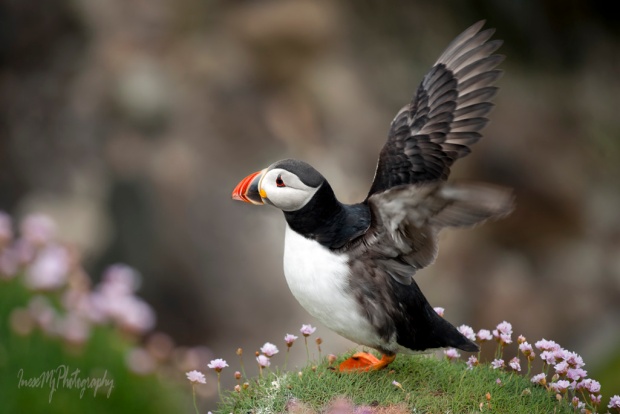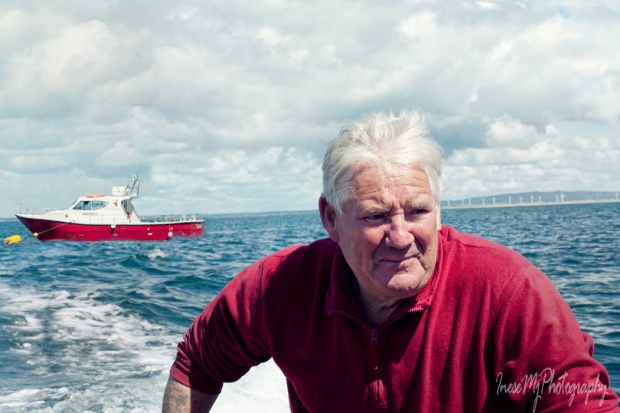Kilmore Quay, Co Wexford, is a fishing village from where you would take a boat to travel over to Great Saltee.
Seabirds here are foraging around the fishing vessels and chippers. See who is lucky today? This Great black backed gull got a crab, and the Herring gull – a chunk of battered fish.
Before we begin our walk, please watch this 2 minute ‘bird eye’ video, and visit this web page to look through the colorful pictures 🙂
We will take a short walk just to see a glimpse of what Killmore Quay has to offer, and I plan on writing more blogs in the future.
At low tide we walk east from the marina along the shingle beach to St. Patrick’s Bridge, a natural bouldery gravel causeway, glacial deposit where the real St. Patrick has probably never set foot – though legends say different. He was chasing the Devil who took a bite of a mountain in Tipperery, The Devil’s Bite mountain. I am planning to go there this year as a part of a project. Anyway, the Devil quickly realised that he had bit more than he could chew and spat the Rock of Cashel, but St. Patrick kept chasing him and throwing rocks at him until he was gone under the water. It is how the Bridge and Saltee islands were formed.
A product of the last Ice Age, St. Patrick’s Bridge is believed to be a moraine. The boulders you see in the picture below are so-called erratics, very large boulders of a rock type that is not found locally, which means they were carried by the ice. The biggest erratic is seen on the left, and has a name – St. Patrick’s Rock. Naturally 🙂
In the 18th century, local fishermen started building a safe haven to moor their boats. They collected the rocks from St. Patrick’s Bridge and transported them to the village where the rocks were piled to create an L-shape barrier – a predecessor of the harbour we know today. The first pier was constructed in the mid 19th century, and the major redevelopment took place in the 1990s.
Centuries pass by but St. Patrick’s Bridge still curves out to Little Saltee, and they say that “no stones are washed from it”.
I spotted a Ruddy turnstone on my way back to the marina.
There are two different formations in Kilmore Quay which are often confused one for another in photographs. St. Patrick’s Bridge is the one on the right (East) from marina, and the Forlorn Point causeway is on the left (West).

Storm Ophelia that hit Ireland in 2017, unearthed an ancient body at Forlorn Point. The body was once buried there, not washed up by the sea.
A herring gull landed on the old boat.
Unnamed C.92 is navigating the sea of grass these days.
Past Forlorn Point, overlooking Ballyteigue Bay there stands a sculpture depicting a grieving couple. The stretch of sea from the Hook Head to Tuskar Rock, is called Graveyard of a thousand ships. And not only ships. Aer Lingus flight 712 went down into the sea off Tuskar Rock when en route from Cork to London on 24 March 1968, killing all 61 people on board. A cause of the crash was never determined, and only 14 bodies were recovered.
Remembrance Garden is dedicated to the memory of those lost at sea. Some families have no graveside to visit. They can come and grieve for their loved ones here, in this beautiful peaceful place.
The garden incorporates a propeller blade from the SS Lennox sunk off the Saltee Islands in 1916. Her crew was saved by the Kilmore lifeboat.
When the promenade ends, we step on a path that takes us to Ballyteige Burrow – a natural treasure of County Wexford.
I didn’t have much time that day. At the first opportunity I crossed the dunes towards the sea and after 50 min was back at the Remembrance Garden. This map is to show you all the 9 km of the narrow coastal townland consisting of a series of sand dunes and hollows, and circled is the part I have walked across.
Ballyteige Burrow dunes are 2000 years old.

Why ‘burrow’? The townland was managed as a rabbit warren for over 600 years. Rabbits are not native to Ireland. The Normans brought them as a source of protein for their armies.
The sand dunes include embryo dunes, shifting dunes and fixed dunes, each with their own type of vegetation. Coastal flora is diverse, even though it doesn’t look so from the first sight because many plant species are tiny and hidden in the grasses. March orchid is the most spectacular flower that will catch your eye.
Sea bindweed is different from the familiar Field bindweed – the leaves are small and fleshy, and the trumpet is vivid pink. They call it The Prince’s flower.
In this picture you also see the green stems of Prickly saltwort.
On my way I take many photographs and make a few compositions that will be put to use in the future.
Sea carrot is hosting a wild Red soldier beetle party.
I wouldn’t notice the tiny Burnet rose, not higher than 4 inches, if not for the bright shiny hips.
The path is not paved, but it is distinct and probably used by both humans and wildlife. It doesn’t go straight to the sea. Instead, it is winding between the dunes, up and down. Breathless I get to the top only to see another dune. Well, even if we get lost, the longest we have to walk is 9 km ( 6 miles). Phew 😉
We can see far away from the top of a high dune. Ballyteige Castle in the picture below was built by Sir Walter de Whitty, a Norman settler. It is a typical tower-house built to protect the household. Members of the Whitty family managed the rabbit warren at Ballyteige Burrow.
The roofs of Kilmore hidden behind a fixed dune.
Marram grass.
Vegetation is changing, and we can feel the fresh breeze – the sea is near, at last.
This view is so Wexford!
The beach looks deserted apart from a small tent pitched in the sand. Some other time we will walk all the 6 miles, but today we turn east and walk back to the marina car park.
A huge piece of kelp with rhizoids washed up in the sand. Here is a good website Galloway Wild Foods for those who is interested in foraging. I am too tired to pick up the heavy kelp.
The Forlorn Point looks close but it takes another 15 minutes to get there – walking on soft sand is, well, hard.
This picture was taken from the Great Saltee. The seagull’s bill points straight to the Forlorn Point, and the beach and dunes are on the left hand side.
This is the Great Saltee as you see it from the Forlorn Point. Our trip is complete, at least for today.
One more bird shot before we leave Kilmore Quay.
Here is the last video to summarize your day 🙂 Thank you for joining the walk. See you in a week at Spraoi 2019 street festival!
 Have a wonderful weekend!
Have a wonderful weekend!
















































































 Have a wonderful weekend!
Have a wonderful weekend!

























 Have a wonderful week!
Have a wonderful week!


















